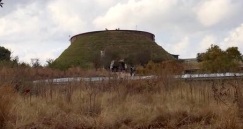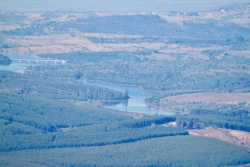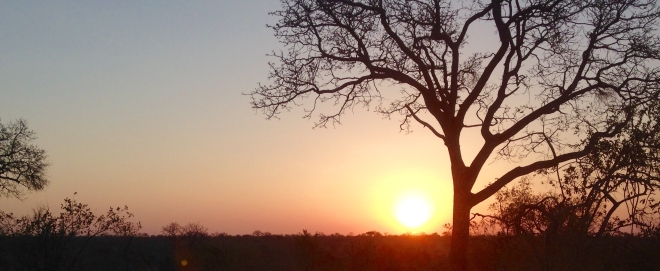The first thing you notice when you drive out of Johannesburg is the vastness of the landscape. It stretches in endless fields of grass that flow in the breeze like the lion’s mane. Patched with light gold and green against a vivid blue sky, it is a restful experience after the toils of the city.
The savannahs of Africa rolled out a welcome to us as we journeyed to check out a part of the continent where mankind originated… after all it was the original home of our ancestors and that is where we all belonged… between Ethiopia, where lived Lucy, and South Africa, where were unearthed more bones of our ancestors who lived there many thousands and millions of years ago. We only moved out to populate the world about a hundred thousand years ago….

We went to Maropeng to familiarize ourselves with what is known as the Cradle of Humankind. Maropeng rose out of the landscape like the hills that dotted all of this area. It was covered with green grass and resembled a small hillock. Only, we went inside this hillock to a museum that exhibited the bones found in the Cradle of Humankind. The Cradle of Humankind are a series of underground limestone caves which stretch 47, 000 hectares 50 km to the south of Johannesburg. Prior to 2010, it hosted more than a third of hominid fossils dating back to 3.5 million years. Here they found the skull of Mrs Ples, a 2.3 million year old fossil dug up in 1947, little younger to the 3.2 million year old Lucy found in Ethiopia. The most remarkable thing about the museum was that it started by telling us we were all united!

The skull is exhibited in the Maropeng visitor center and museum along with the latest bone findings of the Homo Naledi from the Rising Star Cave Systems. The Rising Star caves housed bones of 15 hominids belonging to a new species in the hominid genealogy, the Homo Naledi. While archaelogists argue whether we have a direct link to Homo Naledi, what I found most interesting in the Maropeng museum was it stated the obvious at the entrance, “We are one species”.
I loved the way the museum posters and write-ups said all mankind is united under the banner of the homo family.
Then we went to explore the Sterkfontien Cave where had rested the bones of Mrs Ples(a 2.3 million old Australopithecus Africanus dug up in 1947). We were welcomed to the ‘home of mankind’ by fellow human guides … only they looked different and spoke better English than what I am used to hearing in Singapore. They began the tour by welcoming us to our homeland! That was most marvelous… it was the first time we were in Africa and yet what a warm welcome!
The caves are actually not visible outside. They lie below the grasslands and hills. The caves are dimly lighted and a have constant temperature of 18degrees Celsius. We had to wear helmets with lights. It is not possible to go through these caves without guides, as people have been lost when they have wandered off on their own, I have heard.

We saw the place where they found Mrs Ples, strange rock formations, stalactites and stalagmites. Sometimes, we needed to crawl because the roof was so low and, sometimes, we needed to slide down smooth rock formations. We could not see much. One of the most interesting things was an underground lake. It had very clear water but we were not allowed to touch it, as this is a protected world heritage site. The guide shone her torch into the water and showed us eyeless worms. They were squiggling near the edges! As we slid down the last rock slide, the guide turned off the light and the cave was plunged into frightening abysmal darkness. We could not see our own hands! Perhaps this is what Allain Quatermain and his friends experienced when they were trapped in the treasure caves of King Solomon’s Mines…
I have never been caving but after the sweat, darkness, physical exertion and fear generated in my heart, I would still want to go back into more such caves. It was a cathartic experience. When we came out, I felt so fortunate to be alive and well! I experienced a sense of victory. I felt like an adventurer out of Indiana Jones, Laura Croft, Journey to the Centre of the Earth and King Solomon’s Mines. It gave me a sense of achievement to have survived what Mrs Ples or the less fortunate Homo Naledi could not survive. The guide told us that one of the possibilities was that these ancient creatures had fallen into sinkholes created by the large system of limestone caves in Africa! And in those days, there was no rescue and no lights inside the caves!
While, the Maropeng experience gave us a sense of being one species, the newly opened Apartheid Museum in Johannesburg, made clear how men drew borders and hurt his fellow creatures to have what they considered a comfortable life.

Sub-Saharan Africa had remained untouched by the outside world till the fifteenth century when Bartholomew Diaz found the Cape of Good Hope. After that ‘Gold, Glory and God’ found their way into different parts over the centuries. It was sad to see how the African hunter-gatherer culture was annihilated to a large extent by the colonizers who sought to raise the standards of the local population by cultural imposition. This must have been one of the bleakest periods in human history as with the help of technology and gunpowder the colonizers ‘tamed’ the colonized, worldwide. And it was only twenty years ago that South Africa was officially rid of apartheid. There were artifacts from the past and photographs documenting the plight mankind suffered.
Near the Apartheid Museum, is the Gold Reef City. This is an amusement park made out of an abandoned gold mine. It has good places to eat and it had rides for youngsters, preserved homes of European gold diggers and abandoned gold mines.

The abandoned gold mines were the most interesting to visit. We descended 75 meters into the bowels of the Earth in a miner’s lift. The mine was evidently 4 kms deep. However, it had to be abandoned as it started filling up with water faster than they could pump out. Again, here a guided tour was imperative. Our guide showed us how the miners and overseers worked, dynamite boxes and first aid kits. We could hear the water flow all the time underground and we even saw it seeping through the walls.
This cave or mine was an easy stroll and did not generate any feelings of terror, as did the cave of Mrs Ples. Of course, one has to be free of vertigo, claustrophobia and heart conditions to make this descent. The lift is open and you can see the walls of the mine as you go down. It is an interesting experience.
The homes of the miners were like European cottages with an occasional raucous cry of the hadeda renting the air. Hadedas are one of the most common birds in Johannesburg. You find them everywhere, in gardens, on trees by the roadside… and once they wake up, they make sure everyone wakes up as they keep calling out… On my first day in Johannesburg, I was shocked to hear their call!

These creatures roamed the gardens of the miners and posed for pictures.
One of the quaint things we saw was a cup with a rim to hold up moustaches in one of the parlors! Unfortunately, we could not get a good picture of the cup due to it’s positioning. We had to look at the homes and objects through glass windows that restricted us only to the corridors of the homes. My younger son was fascinated by an ancient bathroom, a long drop!
Sandwiched between Johannesburg and Kruger Park is the scenic Panorama Drive. It passes through scenic Transvaal country. We stopped at a place called Dullstroom for lunch. This was a colonial settlement and looks like a little European town. Dullstroom is known for its trout. The place reminded me of a little town I had seen twenty years ago in USA called Helen of Georgia. It had the same old world charm with the addition of excellent trout that we had for lunch. The service was good and the bathrooms, like elsewhere in South Africa, very clean!

Along the Panorama Drive, we saw another abandoned gold farm, now called Bourke’s Luck Potholes for the strange holes hewn into the rocks. This is located a few hours drive from Johannesburg and very close to the Kruger National Park in an area called, Mpumalanga. The Potholes are named after the gold digger who bought this land to mine gold. It is at the junction of the Blyde River, the river of joy, and the Treur River, the river of mourning. The Treur is a tributary of Blyde but was named the river of mourning in 1844. A group of Voortrekkers under Hendrik Potgieter was thought to have been lost as they sailed down this river. Hence it was named Treur, mourning. However, when they returned from Mozambique along another part of the river, it was christened, Blyde, the river of joy.
The rocks at Potholes are hewn into formations like Swiss cheese or potholes. The colors of the rocks range from white and black to red and yellow. The currents are really strong. The ultimate beauty is the wide and high waterfall that gushes over these formations. Potholes, despite its strange nomenclature is one of the most beautiful spots in the world.

A little further down north is the Blyde River Canyon. This is one of the largest canyons in the world (according to Wikipedia) and, surprisingly, very green. It is a remarkable sight!
Along the canyon are the three Rondavels, a curious mountain formation that looks like thatched huts or rondavels. These formations are a result of erosion. The three geological formations along with the flat-topped mountain were at one time referred to as ‘The Chief and his three wives’. The flat topped mountain was named Mapjaneng (the chief) after a legendary Bapedi chief who defeated the invading Swazis in a battle near here.

The three peaks (from left to right) were named Magabolie, Mogoladikwe and Maseroto, after his three wives.
The Panorama Drive along the Blyde River transports one to unusual landscapes which haunt the senses with their uncanny and stunning colors and appearance.

God’s window, another attraction along the drive, is supposed to be very scenic with a fabulous view. It is scenic but after Potholes and the Rondavels, you wonder why they call it God’s windows… It has a great view but to me the Potholes were the most amazing of all God’s creation.
The distances in South Africa are vast. And it is truly glorious to have the feeling of endlessness that stretches out through the laid back landscape and the open clear skies. Their sunsets and sunrises leave one amazed. The panorama of the colors range from purple, yellow, gold, orange, blue and it seems the horizon has been set aflame.
While motoring around the vastness and beauty of South Africa, one feels the stretch and the call of the infinite universe. One falls in love with the vastness and beauty of this unique creation we call our home, the Earth.








